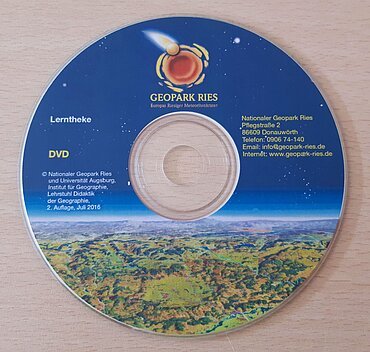Learning Module

The learning module is a lesson module (concept and materials, in German) for students in grades 5 to 7 in all types of schools. The learning module can be used in the fields of geography, chemistry, physics, nature and technology as well as in other subjects related to geo-sciences.
The learning module can be ordered as a DVD from the Geopark Ries management office.
The goal of the learning module is to generate networked knowledge of the “Ries event” in a promising way for learning success. The learning module was developed and tested by the Chair of Geographical Didactics of the Institute of Geography of the University of Augsburg in collaboration with the Geopark Ries.
The learning module can be used in about five teaching hours. It consists of a preparation unit (45 min.), 3-4 implementation units (each 45 min.) and a follow-up unit or knowledge test. The learning module comprises six required stations; in addition there are six optional stations to be voluntarily completed, time permitting. The stations can be used in any order. The students work, as preferred, individually or in groups of up to three.
The required stations have topics based on the Ries event and its consequences for humans and the environment: Soil & farmer, Suevite, Rock layers, Climate & juniper, Location of the Ries, Man in the Ries. The optional stations include the themes: On the track of soil (game), Dimensions, Rock fact sheet, Exceptional profession, Profile through the Ries, First settler.
Function & assembly
The six required stations of the learning module are set up in the classroom, separate from the six optional stations. For each required station there are worksheets, auxiliary materials and help cards. Two stations use additional materials: measuring cup, spoon, modeling clay, cornstarch and atlas.
Each student works through the required stations of the learning module and documents their work on the “control sheet.” The help cards can be used as needed for assistance. The solutions are placed on the teacher’s desk, available so that students can check their results.
Didactic goals
- To promote holistic consideration of the system Earth-Mankind; relating to asteroid impact, demonstrating links between subsystems, system behavior such as dynamic, emergence, complexity—especially with regard to further geographical consequences (agriculture as adaptation to natural circumstances, use of rock, tourism, etc.).
- To strive for an expanded term of learning (taking into account methodical-strategic, social and personal learning).
- To facilitate constructive learning (self-guidance at chosen points, considering subjectivity, activating the student and activity orientation).
In summary: Promote interest in geo-scientific subject matter.

